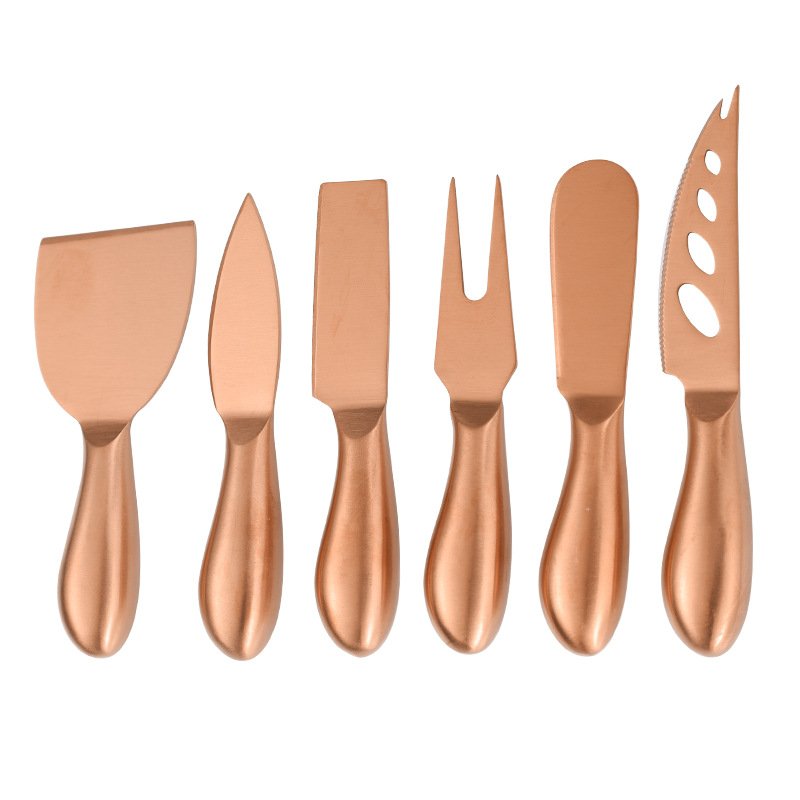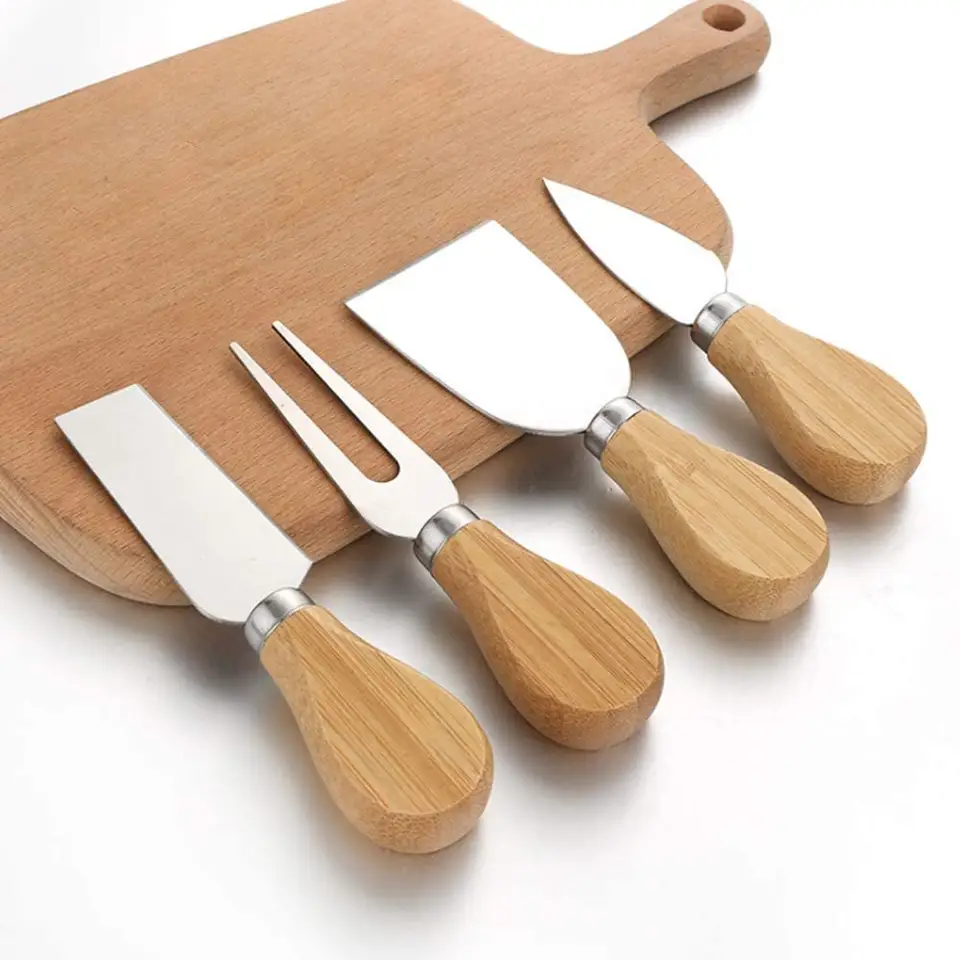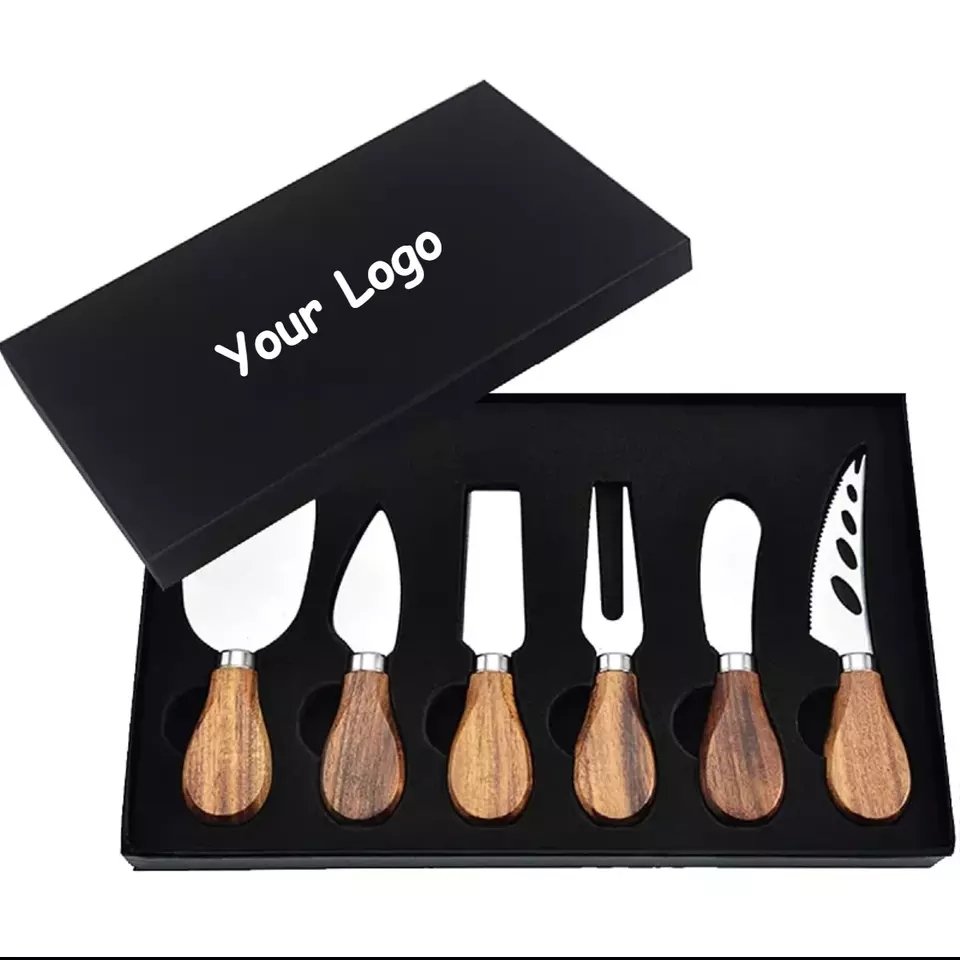I used to struggle with choosing the right cheese knife size. I saw uneven slices ruin a platter at a friend’s dinner party.
Finding the perfect size helps you slice cheese with ease and consistency. You get neat portions that look professional and taste better.
I want to guide you step by step. You’ll learn how to pick and use the right tools. You’ll feel confident every time you slice cheese.
Table of Contents

How do I choose a cheese slicer?
I once bought a slicer too small for my favorite Gouda. I wasted half the block.
Cheese comes in many shapes and textures. You need the right slicer for each type.
When choosing a slicer, look at blade width, handle comfort, and material. The right mix gives clean cuts and less waste.
Types of Cheese Slicers
| Slicer Type | Best For | Key Feature |
|---|---|---|
| Wire Slicer | Semi-firm to hard cheese | Thin, adjustable wire |
| Plane Slicer | Soft to semi-firm cheese | Flat blade, angled grip |
| Rotary Slicer | Hard cheese | Crank-operated blade |
Blade Width Matters
A wider blade handles larger blocks. A narrow blade gives control on small or soft cheeses. I choose a blade that matches my most-used cheese.
Handle Comfort and Grip
Long slicing sessions need a handle that fits your hand. I prefer textured grips. They stop slips and reduce hand fatigue.
Material and Durability
Stainless steel resists rust. A well-built frame lasts years. I avoid flimsy plastic that bends under pressure.
In practice, I own two slicers. A flexible plane for soft cheese and a sturdy wire slicer for aged blocks. This combo covers most needs. You can foolproof your slicing setup by matching slicer type to cheese texture. Keep both close to your cheese board, and switch as needed. It takes a bit of space but saves time and frustration.
What knife should I use for cheese?
I once tried using my steak knife on Brie. It tore the cheese and made a mess.
You need a knife made for cheese. Its blade shape and edge type matter for clean cuts.
A proper cheese knife often has holes or a forked tip to prevent sticking. It pairs with texture, from soft Brie to hard Parmesan.
Blade Designs for Cheese
| Knife Style | Best For | Design Feature |
|---|---|---|
| Fork-Tip Knife | Soft cheeses | Pronged tip lifts slices |
| Holes-in-Blade Knife | Semi-soft cheeses | Reduces surface friction |
| Narrow Thin Blade | Semi-hard to hard cheese | Minimal cheese contact |
Forked Tip Uses
The forked end lifts slices to your cracker. I use it for Camembert and goat cheese. No need for a separate fork.
Why Holes in the Blade?
Holes let air in, stopping cheese from sticking. I find slicing Swiss or Havarti smoother with this design.
Narrow vs. Wide Blades
Narrow blades cut through hard cheese with less force. A thin profile means less cheese on the blade after each cut.
I keep a set of three knives. Each addresses a cheese family. This way, I never force a tool beyond its design. My guests notice the difference in presentation and taste.
What is the difference between a cheese knife and a normal knife?
I learned the hard way. Using a chef’s knife left cheese sticking to the blade.
Cheese knives have special shapes and edges. They prevent sticking and help portion size.
Normal knives lack holes or narrow profiles. They crush soft cheeses and scratch hard ones.
Key Differences
| Feature | Cheese Knife | Normal Knife |
|---|---|---|
| Blade Shape | Specialized curves or holes | Uniform flat blade |
| Edge Profile | Often non-serrated or lightly serrated | Varies, often serrated |
| Purpose | Clean slicing and portioning | General cutting tasks |
Specialized Curves
Some cheese knives curve to fit cheese blocks. I use a curved knife for Brie wheels to get perfect wedges.
Non-Serrated vs. Serrated
Cheese knives often have smooth edges for clean slices. A serrated knife can tear soft cheeses.
Weight and Balance
Cheese knives are balanced for light slicing. A heavy chef’s knife presses cheese and smears it.
Understanding these differences helps you choose the right tool. I no longer ruin cheese textures. Each knife in my set has a clear purpose.
Should you use a serrated knife for cheese?
I once used a serrated bread knife on cheddar. It left jagged edges.
Serrated edges cut through rind well. But they tear delicate cheese interiors.
Choose serration based on rind hardness. Soft cheeses need smooth blades. Hard rinds benefit from serration.
Serrated Pros and Cons
| Aspect | Pros | Cons |
|---|---|---|
| Cutting Rind | Saws through tough skins | Tears crumbly textures |
| Slice Cleanliness | Good on hard cheese | Jagged edges on soft cheese |
| Maintenance | Long-lasting edge retention | Harder to sharpen |
When to Use Serration
Use a serrated edge on aged cheeses with thick rinds. It handles the exterior without bending.
When to Avoid Serration
Soft cheeses like Brie or Camembert need a smooth cut. A serrated blade pulls and smears the cheese.
Sharpening Considerations
Serrated blades require special tools. I maintain mine every few months to keep teeth sharp.
By understanding serration, you pick the right knife. I switch between smooth and serrated depending on cheese type. This ensures consistent, attractive slices.
How sharp is a cheese knife?
I once bought a dull slicer that squashed my cheese.
Cheese knives need enough sharpness to slice but not overkill that cuts too deep into soft cheese.
Blade sharpness is rated by angle. A 15° edge slices hard cheese easily. Soft cheese needs a wider angle.
Sharpness Scale
| Cheese Type | Edge Angle Recommendation | Blade Finish |
|---|---|---|
| Hard (Parmesan) | 15° | Polished |
| Semi-hard (Gouda) | 20° | Satin |
| Soft (Brie) | 25° | Matte or non-stick |
Why Edge Angle Matters
A narrow edge cuts harder cheese with less effort. I prefer 15° for my aged cheddars.
Soft Cheese and Blade Finish
A less polished finish holds cheese less. I use blades with a matte finish for Brie.
Maintaining Sharpness
I hone my blades before every use. A quick hone keeps edges working well without removing metal.
Knowing sharpness keeps your cuts clean. I balance between a keen edge and ease of use. This approach gives me perfect slices every time.

What is the difference between a butter knife and a cheese knife?
I tried spreading cheese with a butter knife once. It slipped off and made a mess.
Butter knives have blunt edges. Cheese knives have sharper, often specialized blades.
Butter knives are for spreading. Cheese knives are for slicing and portioning.
Feature Comparison
| Feature | Butter Knife | Cheese Knife |
|---|---|---|
| Edge | Blunt | Sharp or lightly serrated |
| Blade Shape | Rounded tip | Pointed or forked tip |
| Purpose | Spreading | Slicing and serving |
Edge Sharpness
Butter knives cut nothing. They spread butter. Cheese knives slice through cheese.
Blade Profile
Butter knives are flat. Cheese knives have curves or forks. I pick tools built for the task.
Serving vs. Slicing
Butter knives stay on the serving plate. Cheese knives go through the block. Each tool stays where it belongs.
Using each knife correctly makes prep smoother. I keep butter knives and cheese knives separate. This keeps flavors pure and tools last longer.

What is a good cheese cutter?
I tested dozens of cutters before finding my favorite.
A good cutter suits the cheese type and your style. It balances blade, handle, and size.
Look for sturdy construction, comfortable grip, and the right blade for your cheese habits.
Cutter Qualities
| Quality | Why It Matters | My Preference |
|---|---|---|
| Build Material | Durability and hygiene | Stainless steel frame |
| Handle Grip | Comfort and control | Textured rubber |
| Blade Type | Match cheese texture | Interchangeable blades |
Interchangeable Blades
Some cutters swap blades. I switch between plane and wire. This covers more cheese types.
Ergonomic Handles
I hold my cutter for long prep sessions. A textured grip stops slippage.
Ease of Cleaning
A good cutter disassembles easily. I wash mine in the top rack without worry.
Choosing a cutter is personal. I balance comfort, performance, and style. My top pick handles my most-used cheeses without strain.
I now slice every cheese with precision. You can too with the right tools. Choose wisely. Enjoy your perfect cheese slices.





